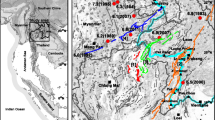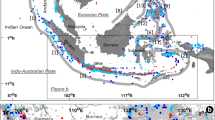Abstract
Due to the extremely complex regional geological tectonic movements in the Alpide Himalayan seismic belt with the dense population and rapid economic development, the frequent seismic activity has caused huge concern. In geology, the research on the spatiotemporal characteristics of seismic activity in different areas at different scales has always been valuable to explore the mechanism of seismic activity for further simulation and prediction of the seismic activity. Using the spatial autocorrelation analysis in this study, we analyzed the spatiotemporal dynamic characteristics of seismic activity in the Alpide Himalayan seismic belt. According to the historical earthquake list (from 1973 to 2017), the data are divided into five periods. Compared with the commonality and diversity of the spatiotemporal characteristics of seismic activity in different periods, it shows that: there is a positive spatial autocorrelation in each period, which proves the spatial aggregation of the seismic activity in the Alpide Himalayan seismic belt. Nevertheless, over time, the spatial aggregation distribution is gradually diminishing from 1973 to 2017; From the Local Spatial Autocorrelation analysis, the spatial aggregation characteristics of seismic activity change with time and have a significant differentiation among the regions. According to the comparison of Local Spatial Autocorrelation characteristics in different periods, seismic activities in the Alpide Himalayan seismic belt were consistent with the periodic characteristics. Assuming the alternating seismic calm period and active period, we could notice that it turned from the active period to the calm period around 2008, which is the most recent turning point between the active and calm periods. At last, the spatio-temporal dynamic characteristics of the seismic activity in the Alpide Himalayan seismic belt is not only consistent with the formation mechanism of seismic activity but also represents the spatial disparity of the geological tectonic movements. It is the feasibility and effectiveness to explore the seismic mechanism based on spatio-temporal dynamic characteristics of the seismic activity.





Similar content being viewed by others
References
Abe K (1981) Magnitudes of large shallow earthquakes from 1904 to 1980 physics of the earth and planetary interiors 27:72-92
Al-Ahmadi K, Al-Amri A, See L (2014) A spatial statistical analysis of the occurrence of earthquakes along the Red Sea floor spreading: Clusters of seismicity. Arabian Journal of Geosciences 7:2893–2904
Al-Ahmadi K, Al-Zahrani A (2013) Spatial autocorrelation of cancer incidence in Saudi Arabia. International Journal of Environmental Research and Public Health 10:7207–7228
Bird P (2003) An updated digital model of plate boundaries geochemistry. Geophysics, Geosystems 4:1027. https://doi.org/10.1029/2001gc000252
Boots B, Tiefelsdorf M (2000) Global and local spatial autocorrelation in bounded regular tessellations. Journal of Geographical Systems 2:319–348
Console R, Murru M, Lombardi AM (2003) Refining earthquake clustering models. Journal of Geophysical Research: Solid Earth 108:2468
Danese M, Lazzari M, Murgante B (2009a) Geostatistics in historical macroseismic data analysis. In: Gavrilova ML, Tan CJK (eds) Transactions on computational science VI. Springer, Berlin, Heidelberg, pp 324–341
Danese M, Lazzari M, Murgante B (2009b) integrated geological, geomorphological and geostatistical analysis to study macroseismic effects of 1980 Irpinian earthquake in urban areas (southern Italy). Paper presented at the ICCSA: International Conference on Computational Science and Its Applications
Donner RV, Zou Y, Donges JF, Marwan N, Kurths J (2010) Recurrence networks—A novel paradigm for nonlinear time series analysis. New Journal of Physics 12:033025
Dormann CF et al (2007) Methods to account for spatial autocorrelation in the analysis of species distributional data: a review. Ecography 30:609–628
Kagan YY (2010) Statistical distributions of earthquake numbers: consequence of branching process. Geophysical Journal International 180:1313–1328
Li X, Zheng W, Wang D, Yin L, Wang Y (2015) Predicting seismicity trend in southwest of China based on wavelet analysis international journal of wavelets, multiresolution and information processing 13 doi:https://doi.org/10.1142/s0219691315500113
Ma K-F, Mori J, Lee S-J, Yu SB (2001) Spatial and temporal distribution of slip for the 1999 chi-chi. Taiwan, earthquake Bulletin of the Seismological Society of America 91:1069–1087
McKenzie D (1978) Active tectonics of the Alpine - Himalayan belt: the Aegean Sea and surrounding regions. Geophys J R Astron Soc 55:217–254
Ogata Y, Katsura K (2007) Analysis of temporal and spatial heterogeneity of magnitude frequency distribution inferred from earthquake catalogues. Geophysical Journal International 113:727–738
Rao NM, Kaila KL (1986) Model of earthquake-energy periodicity in the Alpide-Himalayan seismotectonic belt. Tectonophysics 124:261–270
Shao Z-G, Ma H-S, Li Z-X, Zhang G-M (2009) Temporal and spatial characteristics of strong earthquake activities in Mainland China Earthquake 29:98–106
Telesca L (2010) A non-extensive approach in investigating the seismicity of L’Aquila area (Central Italy), struck by the 6 April 2009 earthquake (ML= 5.8) Terra Nova 22:87-93
Telesca L, Lovallo M, Lapenna V, Macchiato M (2007) Long-range correlations in two-dimensional spatio-temporal seismic fluctuations. Physica A: Statistical Mechanics and its Applications 337:279–284
Vere-Jones D (2009) Some models and procedures for space-time point processes. Environ Ecol Stat 16:173–195
Yin L, Li X, Zheng W, Yin Z, Song L, Ge L, Zeng Q (2019) Fractal dimension analysis for seismicity spatial and temporal distribution in the circum-Pacific seismic belt. Journal of Earth System Science 128:22. https://doi.org/10.1007/s12040-018-1040-2
Zhang Y, Wang L, Dong R, Guo W, Wang X (1984) The seismicity and plate tectonics in Eurasia. Journal of Seismological Research 7:239–252
X-y Z, Su Y-j FH, Wu C-D (2007) Recent tectonic stress field of Eurasian earthquake zone and the characteristics of its subareas. Journal of Seismological Research (in Chinese) 30:146–151
Zheng W et al (2013) Applications of integrated geophysical method in archaeological surveys of the ancient Shu ruins. Journal of Archaeological Science 40:166–175. https://doi.org/10.1016/j.jas.2012.08.022
Zheng W, Li X, Yin L, Wang Y (2015) Spatiotemporal heterogeneity of urban air pollution in China based on spatial analysis. Rendiconti Lincei 27:351–356. https://doi.org/10.1007/s12210-015-0489-z
Zheng W, Li X, Yin L, Yin Z, Yang B, Liu S, Song L, Zhou Y, Li Y (2017) Wavelet analysis of the temporal-spatial distribution in the Eurasia seismic belt international journal of wavelets. Multiresolution and Information Processing 15:1750018. https://doi.org/10.1142/s0219691317500187
Acknowledgments
Supported by Fundamental Research Funds for the Central Universities (No. XDJK2019C091, No. SWU116183, and No. XDJK2011C086).
Author information
Authors and Affiliations
Corresponding author
Ethics declarations
Competing interests
the authors have no competing interests to declare.
Additional information
Publisher’s note
Springer Nature remains neutral with regard to jurisdictional claims in published maps and institutional affiliations.
Electronic supplementary material
ESM 1
(XLSX 46154 kb)
Rights and permissions
About this article
Cite this article
Li, X., Yin, L., Yao, L. et al. Seismic spatiotemporal characteristics in the Alpide Himalayan Seismic Belt. Earth Sci Inform 13, 883–892 (2020). https://doi.org/10.1007/s12145-020-00468-3
Received:
Accepted:
Published:
Issue Date:
DOI: https://doi.org/10.1007/s12145-020-00468-3




